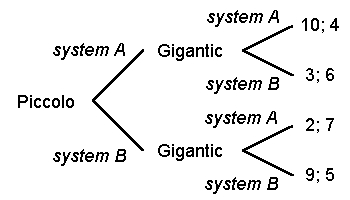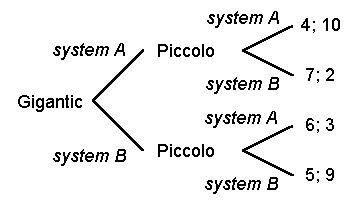Who wants to be No. 1? I bet everybody wants. That’s what we all have learnt from the world. In order to be successful in life one needs to think differently and come up with innovative ideas. Also one needs to have an inborn leadership quality and vision so that one can lead an unbeaten path. These are the best recipes for success, we have been told. But is it so?
Anyone who watched short-track speed skating during the Winter Olympics knows that skating with the lead is no easy task. The No. 2 skater gets to conserve precious energy by drafting behind the leader. He watches the front-runner's every move, gauging when and where to make his bid for gold.
There are many such instances in real life where being the No. 1 is not the best option. In other words, First movers are not always able to benefit from being first. Here comes the concept of the “Second Mover Advantage”.
The idea of second mover advantage in not something new in the literature of Game Theory and has many applications in the real world. In a rather simpler example closer to daily life, suppose that two students, Ram and Piya, attend the same school. However, while Ram dislikes Piya, Piya is madly in love with Ram. When it comes to lunch time, they both go to the same dining hall, where there are two big tables. As Ram does not like Piya, he wants her to sit at a different table; Piya on the other hand wants to spend as much time as possible near her beloved Ram. Clearly if Ram sits down first, the two of them will end up sitting at the same table, which is Piya's preferred outcome. If Ram moves second, he will not sit at Piya's table, so he gets his preferred outcome. The second mover will be able to pick his/her/its preferred outcome, and thus enjoys an advantage. Or suppose there is a cake that is to be distributed between Ram and Piya. Let first Ram will cut the cake into two pieces, and then after the cake is cut, Piya will decide which piece of cake will she eat. Assuming both of them love cakes, clearly in this case Piya has a second mover advantage.
In the world of business, First-mover advantage is gained by the initial occupant of a market segment. This advantage may stem from the fact that the first entrant can gain control of resources that followers may not be able to match or the ability to register patents and trademarks that will protect the first entrant from future competition or by changing the economics of the market in a way that second entrants will not have an economic justification to enter.
However, the first movers are not always able to benefit from being first. Whereas firms who are the first to enter the market with a new product can gain substantial market share due to lack of competition, sometimes their efforts fail. Second-mover advantage occurs when a firm who follows the lead of the first-mover is actually able to capture greater market share, despite having entered late.
First-mover firms often face high research and development costs and the marketing costs necessary to educate the public about a new type of product. A second-mover firm can learn from the experiences of the first mover firm and may not face such high research and development costs if they are able create their own similar product using existing technology. A second-mover firm also does not face the marketing task of having to educate the public about the new project because the first mover has already done so. As a result, the second-mover can use its resources to focus on making a superior product or out-marketing the first mover.
There is some very solid theoretical background behind this argument. A Second-Mover-Advantage can only, or rather must occur when there is no Nash equilibrium. This theorem is not difficult to show in general terms, but an example will suffice (as shown in the figure).
Suppose in this game there are two firms, call them Piccolo and Gigantic. They both produce similar products; however, Piccolo has only a small market share, while Gigantic controls a large proportion of the market. Both firms want to bring a new product onto the market, for which they must introduce one of two systems. But Gigantic has rather inferior technology compared to Piccolo. If both firms operate with the same system, then the whole market is in that very system, and can choose between the two technologies. It will presumably favour Piccolo. On the other hand, if the two firms operate different systems, Gigantic's customers are stuck with Gigantic's system and hence have no access to Piccolo's advanced technology, which hence can only be sold to Piccolo's market share. According to this rationale the payoffs in Figure (a) are set. Vertically we have Gigantic and horizontally Piccolo.
Fig. (a)
It will be discovered that there is no Nash equilibrium. One will further observe that in spite of the absence of such an equilibrium it is possible to solve the game as long as the sequence of moves is known. If Piccolo moves first, the outcome will be (3; 6). Gigantic would respond to Piccolo having favoured system A by choosing system B (since 6 is a higher payoff than 4). If, on the other hand, Piccolo had chosen system B, Gigantic would react with system A (7 is higher than 5). Piccolo, knowing this, will select system A (3 is higher than 2); the final outcome is hence 3 for Piccolo and 6 for Gigantic (This way of solving games is called ''backward induction''). Similarly, it can be determined that the outcome changes to 9 for Piccolo and 5 for Gigantic, when the order of moves is reversed. Inspection of the outcomes shows clearly, that both Piccolo and Gigantic prefer the equilibrium outcome in the case when they move second respectively; the second mover enjoys the Second-Mover-Advantage.


figure (b)
This second mover advantage has shown much prominence in today’s business where there are very few safe leads. Fluid job markets, plugged-in consumers, and plentiful financing have ushered in an era where being No. 2 has never looked better.
A case in point is Intuit. Intuit is one of the very few desktop software companies to stare down Microsoft at high noon with guns blazing, and live to tell their story. They went head-to-head against Microsoft on three of their flagship products and beat them resoundingly all three times! Quicken beat Microsoft Money, QuickBooks beat Microsoft Profit, and TurboTax beat Microsoft TaxSaver.
Intuit isn't the only No. 2 making mincemeat of the axiom that investing in industry leaders is the surest path to wealth. Target has been thumping Wal-Mart, PepsiCo is out fizzing Coca-Cola, and Advanced Micro Devices is chipping away at Intel. In fact, the annals of high-tech history contain remarkably few companies which translated their first-mover advantage into long-term dominance in the marketplace. For example, the first mover in the business of personal computers was a company named Altair whereas the market leader in PC manufacturing today is Dell. Similarly, lesser known brands like WordStar, Mosaic and Excite enjoyed the fast mover advantage in the field of word processing software, web browser and internet search engine respectively, but none of them is the market leader in those categories or even anywhere near the top - despite the fact that all these products were introduced just 15 to 30 years ago. We all know that the market leaders in these categories are respectively Microsoft Word, Microsoft Internet Explorer and Google.
So, do you still want to be the No. 1?
Anyone who watched short-track speed skating during the Winter Olympics knows that skating with the lead is no easy task. The No. 2 skater gets to conserve precious energy by drafting behind the leader. He watches the front-runner's every move, gauging when and where to make his bid for gold.
There are many such instances in real life where being the No. 1 is not the best option. In other words, First movers are not always able to benefit from being first. Here comes the concept of the “Second Mover Advantage”.
The idea of second mover advantage in not something new in the literature of Game Theory and has many applications in the real world. In a rather simpler example closer to daily life, suppose that two students, Ram and Piya, attend the same school. However, while Ram dislikes Piya, Piya is madly in love with Ram. When it comes to lunch time, they both go to the same dining hall, where there are two big tables. As Ram does not like Piya, he wants her to sit at a different table; Piya on the other hand wants to spend as much time as possible near her beloved Ram. Clearly if Ram sits down first, the two of them will end up sitting at the same table, which is Piya's preferred outcome. If Ram moves second, he will not sit at Piya's table, so he gets his preferred outcome. The second mover will be able to pick his/her/its preferred outcome, and thus enjoys an advantage. Or suppose there is a cake that is to be distributed between Ram and Piya. Let first Ram will cut the cake into two pieces, and then after the cake is cut, Piya will decide which piece of cake will she eat. Assuming both of them love cakes, clearly in this case Piya has a second mover advantage.
In the world of business, First-mover advantage is gained by the initial occupant of a market segment. This advantage may stem from the fact that the first entrant can gain control of resources that followers may not be able to match or the ability to register patents and trademarks that will protect the first entrant from future competition or by changing the economics of the market in a way that second entrants will not have an economic justification to enter.
However, the first movers are not always able to benefit from being first. Whereas firms who are the first to enter the market with a new product can gain substantial market share due to lack of competition, sometimes their efforts fail. Second-mover advantage occurs when a firm who follows the lead of the first-mover is actually able to capture greater market share, despite having entered late.
First-mover firms often face high research and development costs and the marketing costs necessary to educate the public about a new type of product. A second-mover firm can learn from the experiences of the first mover firm and may not face such high research and development costs if they are able create their own similar product using existing technology. A second-mover firm also does not face the marketing task of having to educate the public about the new project because the first mover has already done so. As a result, the second-mover can use its resources to focus on making a superior product or out-marketing the first mover.
There is some very solid theoretical background behind this argument. A Second-Mover-Advantage can only, or rather must occur when there is no Nash equilibrium. This theorem is not difficult to show in general terms, but an example will suffice (as shown in the figure).
Suppose in this game there are two firms, call them Piccolo and Gigantic. They both produce similar products; however, Piccolo has only a small market share, while Gigantic controls a large proportion of the market. Both firms want to bring a new product onto the market, for which they must introduce one of two systems. But Gigantic has rather inferior technology compared to Piccolo. If both firms operate with the same system, then the whole market is in that very system, and can choose between the two technologies. It will presumably favour Piccolo. On the other hand, if the two firms operate different systems, Gigantic's customers are stuck with Gigantic's system and hence have no access to Piccolo's advanced technology, which hence can only be sold to Piccolo's market share. According to this rationale the payoffs in Figure (a) are set. Vertically we have Gigantic and horizontally Piccolo.
| 10, 4 | 3, 6 |
| 2, 6 | 9, 5 |
Fig. (a)
It will be discovered that there is no Nash equilibrium. One will further observe that in spite of the absence of such an equilibrium it is possible to solve the game as long as the sequence of moves is known. If Piccolo moves first, the outcome will be (3; 6). Gigantic would respond to Piccolo having favoured system A by choosing system B (since 6 is a higher payoff than 4). If, on the other hand, Piccolo had chosen system B, Gigantic would react with system A (7 is higher than 5). Piccolo, knowing this, will select system A (3 is higher than 2); the final outcome is hence 3 for Piccolo and 6 for Gigantic (This way of solving games is called ''backward induction''). Similarly, it can be determined that the outcome changes to 9 for Piccolo and 5 for Gigantic, when the order of moves is reversed. Inspection of the outcomes shows clearly, that both Piccolo and Gigantic prefer the equilibrium outcome in the case when they move second respectively; the second mover enjoys the Second-Mover-Advantage.


figure (b)
This second mover advantage has shown much prominence in today’s business where there are very few safe leads. Fluid job markets, plugged-in consumers, and plentiful financing have ushered in an era where being No. 2 has never looked better.
A case in point is Intuit. Intuit is one of the very few desktop software companies to stare down Microsoft at high noon with guns blazing, and live to tell their story. They went head-to-head against Microsoft on three of their flagship products and beat them resoundingly all three times! Quicken beat Microsoft Money, QuickBooks beat Microsoft Profit, and TurboTax beat Microsoft TaxSaver.
Intuit isn't the only No. 2 making mincemeat of the axiom that investing in industry leaders is the surest path to wealth. Target has been thumping Wal-Mart, PepsiCo is out fizzing Coca-Cola, and Advanced Micro Devices is chipping away at Intel. In fact, the annals of high-tech history contain remarkably few companies which translated their first-mover advantage into long-term dominance in the marketplace. For example, the first mover in the business of personal computers was a company named Altair whereas the market leader in PC manufacturing today is Dell. Similarly, lesser known brands like WordStar, Mosaic and Excite enjoyed the fast mover advantage in the field of word processing software, web browser and internet search engine respectively, but none of them is the market leader in those categories or even anywhere near the top - despite the fact that all these products were introduced just 15 to 30 years ago. We all know that the market leaders in these categories are respectively Microsoft Word, Microsoft Internet Explorer and Google.
So, do you still want to be the No. 1?




